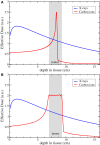The Immunoregulatory Potential of Particle Radiation in Cancer Therapy
- PMID: 28220126
- PMCID: PMC5292767
- DOI: 10.3389/fimmu.2017.00099
The Immunoregulatory Potential of Particle Radiation in Cancer Therapy
Abstract
Cancer treatment, today, consists of surgery, chemotherapy, radiation, and most recently immunotherapy. Combination immunotherapy-radiotherapy (CIR) has experienced a surge in public attention due to numerous clinical publications outlining the reduction or elimination of metastatic disease, following treatment with specifically ipilimumab and radiotherapy. The mechanism behind CIR, however, remains unclear, though it is hypothesized that radiation transforms the tumor into an in situ vaccine which immunotherapy modulates into a larger immune response. To date, the majority of attention has focused on rotating out immunotherapeutics with conventional radiation; however, the unique biological and physical benefits of particle irradiation may prove superior in generation of systemic effect. Here, we review recent advances in CIR, with a particular focus on the usage of charged particles to induce or enhance response to cancerous disease.
Keywords: abscopal; carbon; immunotherapy; particle therapy; proton.
Figures


References
LinkOut - more resources
Full Text Sources
Other Literature Sources

